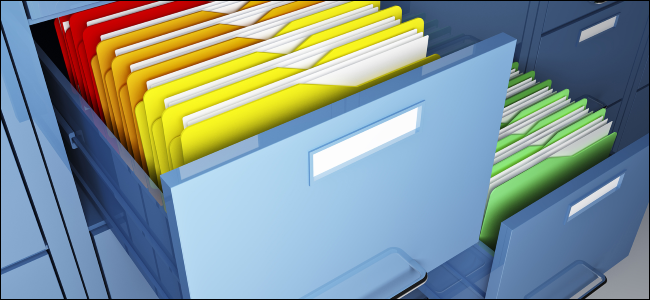The influx of paper into our homes and our businesses is one of the most annoying things we face on a daily basis. There is what comes through the snail mail, forms and responses that people walk into our offices and our homes, all the things you print off on a daily basis and let’s not forget the files and drawers full of the stuff.
It’s easy to see how just letting the paper flow go for a few days can be enough to crash the best organized among us. The trick is to continuously manage the flow – and that’s not as difficult as it seems with a simple system in place that you use to the point of it just becoming a habit you don’t even think about and it happens spontaneously.
There are three basic pillars to my system – point of entry, point of action and point of storage or disposal.
Point of Entry – this one is the source of it all – how and where is the paper entering your household of office? The best management starts at this point. Whether it’s snail mail, email or hand delivered pay attention to how it enters. When it enters you should do one of three things – identify if it is something that will require action now or later? Is it something that just needs to be kept for documentation? Is it something that needs to be discarded or recycled. If it falls into the discard or recycle category it can be dealt with right here and its journey has ended and it won’t end up in a pile. (I always note that you should take the proper precautions when it comes to discarding or recycling items that may contain personal or confidential information – a shredder or a shred box are a very good thing!)
Point of Action – once you know what you are dealing with it’s a matter of dealing with it. Is it something that you can act on immediately? Is it something you need to set aside for action at a specific time or on a specific date? If it is something that I can deal with immediately I set it aside to handle as soon as I’ve completed the process for all items – in other words finish your sorting and then deal with these items immediately and move them to the storage phase. If it is something that requires action –at a later time or date it goes into my “Action” file or bin.
Depending on the volume of items in your action bin or file you can get very original and creative here – it almost depends on how organized you want to be. You can have a master file that you separate into days of the week – placing each item in the corresponding file for the day of the current week you wish to deal with the item. You can have an additional folder that says next week – and at the end of each week pull items and place in the day to be completed as next week becomes your current week. You can also have an additional file for the current month that then feeds into the next week and current week files. You just need to get into the habit of moving things through the files each day and each week and month – it seems a bit complex on paper – but you’ll quickly find you spend a small amount of time each day managing the system. It’s important to note here that you need to keep the action file or files separate from your files you place things for storage – the third pillar of the basic system.
Point of Storage is likely the point where most systems break down – the distinction here is remembering storage and action are two very different elements. Your Action file/folder should not be confused with storage or you’ll quickly become overwhelmed and not be able to find anything. I break my storage into two principle categories. Short term (one year or less) and Long term (more than a year and things that need to be kept for varying reasons.)
My Short Term system is one file drawer that contains files and folders for all of the things that I access on a monthly basis. For example I have files for utilities, credit card accounts, medical files, mortgage, autos, gym memberships etc. As I pay bills, reconcile accounts etc. paperwork is filed in the appropriate folder – once a year I go through and purge these files (So for example in my utility files I have the statement for each month with notation of when it was paid. I always have the complete prior year in each file. – So in January I remove anything from the folder that is more than a year old – so when 2017 started I purged anything older than January 1, 2016.) Some people no longer even keep the previous year of statements with so many things available electronically – but I’m old school and want a little bit of security.
The Long Term files are documents that you need for reference – some of these are actually kept in a fire proof safe – information on life insurance, home owners and auto insurance polices – retirement account information – files to collect information for the upcoming tax year, etc. This is also where you can keep any information you need from previous employers, etc. I move files from my short term system to this system when they need – for instance if you close a credit card account but want to keep information on the account just incase you need it in the future. I then review and purge these files on an annual basis.
It’s important to remember there are no hard and fast rules to how you set up your system what’s most important is that it works for you and that it is something that you can easily master so that implementing it isn’t difficult and becomes second nature!
Do you have a system or tip you would like to share? Drop us a note at info@thetaskathand.biz and you may find we share it in an upcoming blog or one of our regular posts on our Facebook page!


57 Comments
Good article and right to the point. I don’t know if
this is really the best place to ask but do you guys
have any ideea where to employ some professional writers?
Thanks 🙂 Escape room lista
Hello There. I found your blog the usage of msn. This is a really smartly written article.
I will make sure to bookmark it and come back to read more of your helpful information. Thank you for the
post. I’ll definitely return.
Also visit my web page … website
mexican drugstore online: mexican online pharmacy – purple pharmacy mexico price list
indian pharmacy reputable indian pharmacies buy medicines online in india
safe online pharmacies in canada: cheap canadian pharmacy – legit canadian online pharmacy
indian pharmacy online: indianpharmacy com – indian pharmacy
https://indiapharmast.com/# india online pharmacy
Online medicine home delivery pharmacy website india top online pharmacy india
http://foruspharma.com/# buying prescription drugs in mexico
medicine in mexico pharmacies medicine in mexico pharmacies purple pharmacy mexico price list
purple pharmacy mexico price list: mexico drug stores pharmacies – mexican rx online
northwest pharmacy canada: canadianpharmacyworld – prescription drugs canada buy online
canada drugs: canadian pharmacy india – canadian pharmacy world
legitimate canadian pharmacy buy drugs from canada onlinecanadianpharmacy
https://foruspharma.com/# mexican mail order pharmacies
buying prescription drugs in mexico online: mexican pharmacy – mexico pharmacy
online canadian pharmacy: canadian world pharmacy – canadian pharmacy ratings
top online pharmacy india: online pharmacy india – buy medicines online in india
india pharmacy mail order: india pharmacy mail order – best india pharmacy
http://indiapharmast.com/# online shopping pharmacy india
mexico pharmacies prescription drugs buying from online mexican pharmacy mexican online pharmacies prescription drugs
mexico pharmacy: mexican online pharmacies prescription drugs – mexico drug stores pharmacies
https://indiapharmast.com/# reputable indian online pharmacy
canadianpharmacyworld: canadian pharmacies compare – best canadian pharmacy
top 10 pharmacies in india: reputable indian pharmacies – indian pharmacy paypal
top 10 pharmacies in india: indian pharmacy online – top 10 online pharmacy in india
https://indiapharmast.com/# indian pharmacies safe
purple pharmacy mexico price list buying prescription drugs in mexico reputable mexican pharmacies online
875 mg amoxicillin cost: order amoxicillin 500mg – amoxicillin 500mg capsules antibiotic
http://paxloviddelivery.pro/# Paxlovid buy online
Paxlovid buy online paxlovid price Paxlovid over the counter
https://doxycyclinedelivery.pro/# doxycycline 100mg online
doxycycline medicine in india doxycycline 100mg otc order doxycycline uk
http://clomiddelivery.pro/# where can i get clomid prices
paxlovid pharmacy: paxlovid price – paxlovid pill
http://clomiddelivery.pro/# order clomid tablets
how to get clomid for sale: can you buy cheap clomid pill – where can i buy generic clomid without prescription
how to get amoxicillin: amoxicillin 500mg pill – cost of amoxicillin prescription
https://doxycyclinedelivery.pro/# buy doxycycline 200 mg
paxlovid generic paxlovid india paxlovid cost without insurance
http://amoxildelivery.pro/# amoxicillin 500 mg cost
https://paxloviddelivery.pro/# Paxlovid over the counter
can you buy generic clomid no prescription can you get cheap clomid without prescription can i purchase generic clomid without prescription
buy ciprofloxacin over the counter: buy generic ciprofloxacin – cipro ciprofloxacin
http://paxloviddelivery.pro/# paxlovid covid
paxlovid covid: paxlovid price – paxlovid covid
https://amoxildelivery.pro/# cost of amoxicillin 875 mg
amoxicillin 500 mg capsule cost of amoxicillin 875 mg amoxicillin 30 capsules price
price doxycycline: doxycycline for sale online uk – doxycycline purchase
http://ciprodelivery.pro/# antibiotics cipro
http://clomiddelivery.pro/# how can i get generic clomid
cipro pharmacy where can i buy cipro online buy cipro online
amoxicillin 500mg buy online canada: where can i buy amoxicillin without prec – can you buy amoxicillin over the counter
http://amoxildelivery.pro/# amoxacillian without a percription
п»їpaxlovid: paxlovid price – Paxlovid buy online
http://amoxildelivery.pro/# amoxicillin medicine over the counter
buy cipro cheap buy generic ciprofloxacin buy cipro
http://amoxildelivery.pro/# buy cheap amoxicillin online
https://paxloviddelivery.pro/# Paxlovid over the counter
purchase amoxicillin online without prescription amoxicillin order online where can i buy amoxicillin over the counter uk
pharmacy prices for doxycycline: doxycycline capsules purchase – doxycycline 1mg
amoxicillin 250 mg: buying amoxicillin in mexico – how to get amoxicillin over the counter
https://ciprodelivery.pro/# buy cipro online
http://clomiddelivery.pro/# how can i get cheap clomid for sale
paxlovid buy: paxlovid pharmacy – Paxlovid over the counter
http://amoxildelivery.pro/# cost of amoxicillin
Paxlovid over the counter paxlovid pill Paxlovid over the counter
http://paxloviddelivery.pro/# Paxlovid buy online
ciprofloxacin order online buy cipro cheap purchase cipro
buy cipro online canada: cipro – ciprofloxacin 500mg buy online
http://ciprodelivery.pro/# ciprofloxacin order online
http://doxycyclinedelivery.pro/# generic doxycycline
Paxlovid buy online: paxlovid price – paxlovid india
cipro for sale: cipro for sale – buy cipro online without prescription
http://clomiddelivery.pro/# how can i get clomid without a prescription
where can i get cheap clomid without prescription clomid for sale can i order clomid for sale
http://clomiddelivery.pro/# how to buy generic clomid online
ciprofloxacin ciprofloxacin generic buy ciprofloxacin over the counter
https://clomiddelivery.pro/# how can i get clomid online
buy paxlovid online: paxlovid pharmacy – paxlovid india
http://paxloviddelivery.pro/# Paxlovid over the counter
buy cipro without rx: buy cipro no rx – п»їcipro generic
https://amoxildelivery.pro/# amoxicillin without rx
http://ciprodelivery.pro/# buy cipro cheap
buy doxycycline monohydrate 100 mg doxycycline price of doxycycline in india
how to buy generic clomid: can you buy generic clomid without insurance – can you get cheap clomid without prescription
https://doxycyclinedelivery.pro/# doxycycline online india
can i get cheap clomid without prescription: buy cheap clomid without prescription – can you buy cheap clomid no prescription
buy paxlovid online: paxlovid price – paxlovid generic